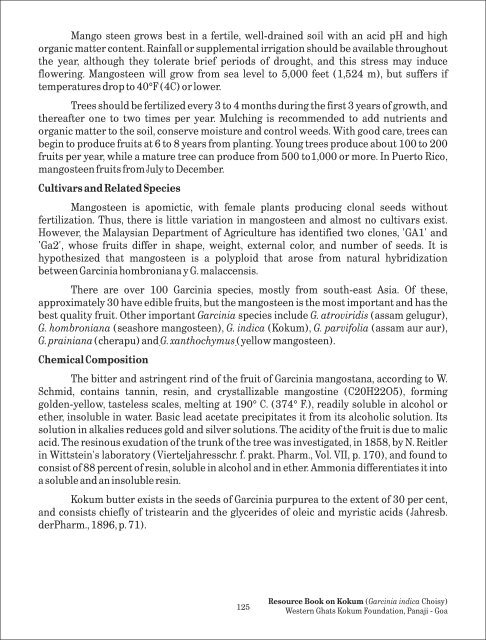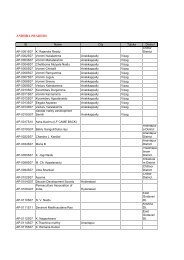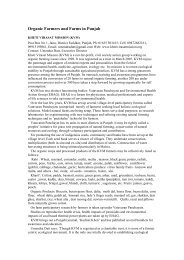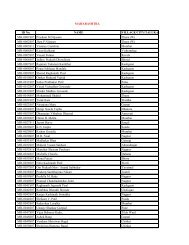Western Ghats Kokum Foundation - Organic Farming Association of ...
Western Ghats Kokum Foundation - Organic Farming Association of ...
Western Ghats Kokum Foundation - Organic Farming Association of ...
You also want an ePaper? Increase the reach of your titles
YUMPU automatically turns print PDFs into web optimized ePapers that Google loves.
Mango steen grows best in a fertile, well-drained soil with an acid pH and high<br />
organic matter content. Rainfall or supplemental irrigation should be available throughout<br />
the year, although they tolerate brief periods <strong>of</strong> drought, and this stress may induce<br />
flowering. Mangosteen will grow from sea level to 5,000 feet (1,524 m), but suffers if<br />
temperatures drop to 40°F (4C) or lower.<br />
Trees should be fertilized every 3 to 4 months during the first 3 years <strong>of</strong> growth, and<br />
thereafter one to two times per year. Mulching is recommended to add nutrients and<br />
organic matter to the soil, conserve moisture and control weeds. With good care, trees can<br />
begin to produce fruits at 6 to 8 years from planting. Young trees produce about 100 to 200<br />
fruits per year, while a mature tree can produce from 500 to1,000 or more. In Puerto Rico,<br />
mangosteen fruits from July to December.<br />
Cultivars and Related Species<br />
Mangosteen is apomictic, with female plants producing clonal seeds without<br />
fertilization. Thus, there is little variation in mangosteen and almost no cultivars exist.<br />
However, the Malaysian Department <strong>of</strong> Agriculture has identified two clones, 'GA1' and<br />
'Ga2', whose fruits differ in shape, weight, external color, and number <strong>of</strong> seeds. It is<br />
hypothesized that mangosteen is a polyploid that arose from natural hybridization<br />
between Garcinia hombroniana y G. malaccensis.<br />
There are over 100 Garcinia species, mostly from south-east Asia. Of these,<br />
approximately 30 have edible fruits, but the mangosteen is the most important and has the<br />
best quality fruit. Other important Garcinia species include G. atroviridis (assam gelugur),<br />
G. hombroniana (seashore mangosteen), G. indica (<strong>Kokum</strong>), G. parvifolia (assam aur aur),<br />
G. prainiana (cherapu) and G. xanthochymus (yellow mangosteen).<br />
Chemical Composition<br />
The bitter and astringent rind <strong>of</strong> the fruit <strong>of</strong> Garcinia mangostana, according to W.<br />
Schmid, contains tannin, resin, and crystallizable mangostine (C20H22O5), forming<br />
golden-yellow, tasteless scales, melting at 190° C. (374° F.), readily soluble in alcohol or<br />
ether, insoluble in water. Basic lead acetate precipitates it from its alcoholic solution. Its<br />
solution in alkalies reduces gold and silver solutions. The acidity <strong>of</strong> the fruit is due to malic<br />
acid. The resinous exudation <strong>of</strong> the trunk <strong>of</strong> the tree was investigated, in 1858, by N. Reitler<br />
in Wittstein's laboratory (Vierteljahresschr. f. prakt. Pharm., Vol. VII, p. 170), and found to<br />
consist <strong>of</strong> 88 percent <strong>of</strong> resin, soluble in alcohol and in ether. Ammonia differentiates it into<br />
a soluble and an insoluble resin.<br />
<strong>Kokum</strong> butter exists in the seeds <strong>of</strong> Garcinia purpurea to the extent <strong>of</strong> 30 per cent,<br />
and consists chiefly <strong>of</strong> tristearin and the glycerides <strong>of</strong> oleic and myristic acids (Jahresb.<br />
derPharm., 1896, p. 71).<br />
125<br />
Resource Book on <strong>Kokum</strong> (Garcinia indica Choisy)<br />
<strong>Western</strong> <strong>Ghats</strong> <strong>Kokum</strong> <strong>Foundation</strong>, Panaji - Goa





